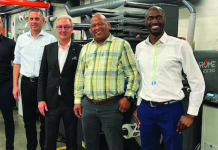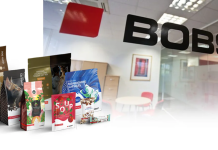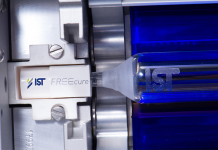EFI, which manufactures and sells the Jetrion Label Printing Solution, has reported that 25 percent of the system’s sales are from commercial printers looking to diversify their product offerings.
Kelly DiMarco, Jetrion Product Manager, said that unlike commercial printing, label production isn’t cyclical, ‘LED lights on packaging aren’t financially reasonable; printed labels are not going to be replaced, they are here to stay.’
As the commercial printing market continues to get battered, some shops are expanding their service offerings into the label space, and with good reason as it’s a growing market. Brands are increasingly seeking out printers that can service more of their overall marketing needs.
This not only includes social media and Internet promotions, but also products such as labels, which help cement the brand’s identity in the consumer’s eye. Printers who can handle all of these different channels are better aligned to succeed in today’s environment, reported Terry Amerine, Business Development Manager, Specialty Media and Equipment, FUJIFILM North America Corporation, Graphic Systems Division.
Although it may be tempting for commercial printers, success within the label market is not a slam dunk, instead, it requires careful planning, a thorough investigation of technology, and a re-tooling of sales and marketing efforts.
‘General commercial printers who have strong logistics management procedures regularly process high volumes of orders, and having effective workflow practices often do well when transitioning to labels and packaging production,’ said Roy Oomen, Labels and Packaging Category Manager at HP. ‘Print service providers (PSPs) who can quickly identify, formulate, and execute an end-to-end strategy successfully for their customers are the ones who advance most quickly. PSPs transitioning into the label space need to have a keen awareness of who prospective customers are and how to reach them.’
Digital printing is helping to drive the commercial printer’s interest, offering an easier and more straightforward path to labels and packaging production than flexographic printing. Similar to the commercial market, run length are shrinking, with 65 percent of global label jobs produced in print runs of fewer than 50000 labels.
For one thing, the digital system eliminates the expense of tooling and die-cutting required with analogue label printing, said DiMarco. ‘Also, you can have one piece of equipment that delivers an end-to-end solution. The necessary touchpoints for production are slashed, from 11 for flexo (from ordering tooling and dies to making plates, pulling dies, mounting plates, to mounting dies for every single job for every single colour) to four for digital.
‘EFI Jetrion 4900 UV inkjet is an end-to-end solution that accomplishes digital printing and finishing in a single pass. Its finishing capabilities include dual-head laser cutting, backed by a web festoon, slitting, and automatic turret rewinding. An off-line finishing module is also available. As digital printing allows brands to tap into cost-effective short-run label production, allowing for localised and customised promotions to the consumer, the printer benefits from a higher margin revenue stream.’
‘In theory, some digital printers/presses can be used to produce labels, but the speed, quality demands, and wide variety of materials used for label makes this impractical,’ said Amerine. ‘This would enable a printer to meet the quality of print requirements while also being able to produce variable data and apply spot colours or clear coats as needed.’
At PRINT 13 Fujifilm, in partnership with UK-based FFEI Ltd., introduced Graphium, a UV inkjet press with a 40,6cm (16-inch) print width for labels, packaging and specialty print applications. It supports up to five digital modules, and six flexo stations, integrating optional flexo and finishing stations in-line for conversion in a single pass.
There are some label presses that can produce some store signage and business cards. ‘Technically, a web format can be converted to a sheet, but with some applications this production workflow is not optimal,’ Oomen explained. ‘Revenue diversification with a new asset is a safe strategy at first, but the goal is to outgrow this phase quickly and deploy capital for specific applications. PSPs seeking to enter label production need to consider their business needs and select a diverse digital press with a wide range of capabilities and substrate versatility. There are often unexpected opportunities for additional revenue streams with a digital business model. In many cases, the products a PSP produces today did not even exist when he or she was originally considering the investment.’
HP Indigo’s ws4500 model offers both in-line and off-line options. The seven-colour capable press uses HP ElectroInk liquid ink technology, and is able to print on a wide spectrum of substrates for a range of label and packaging applications. Along with a printing device, the finishing system is a critical element in any type of label production environment digital or analogue. ‘The ability to die cut and slice larger rolls of labels is essential,’ noted Amerine. ‘The variety of designs required in labels along with tight deadlines make outsourcing next to impossible.’
Oomen said that the absolute essential converting technology includes a slitter/rewinder to deliver labels in the correct wind position for high-speed application to bottles and consumer products and a digital technology-compatible converter, which varies from full rotary solutions to semi rotary and laser converting die-cutting systems. Suppliers who provide this technology include AB Graphic International, Delta Industrial, Smag, CEI, GM (Graphik Machinen), Spartanics, SEI, Preco, among others.
‘There is a high, but not insurmountable, capital investment required to enter the label space, and the cost is a barrier for some, said Oomen. ‘Additionally, entry into label production is not ‘one size fits all’. Pressure sensitive labels, in-mold labels, cut & stack, wrap around, and shrink sleeve labels all require very specific production and converting processes. Commercial printers first entering the market might consider focusing on pressure-sensitive labels, and outsourcing more demanding label production, such as shrink sleeves and in-mold labels.’
‘Materials, as well as roll sizes in terms of widths and length, are completely different than what is found in the commercial market’, said Amerine. ‘It is a totally different segment from commercial printing, with a very diverse landscape in terms of cost, adhesives, abilities for liners, and how the materials operate.’
‘Label converters spend a great deal of time assessing a print effect and how it looks on a specific material,’ Ooman remarked. ‘In the labels and packaging space, an important consideration is functional performance—how the substrate performs its function. There is also a big difference in artwork required for contact printing, such as with flexo analog printing, and non-contact inkjet. With contract printing, the ink is transferred to the paper, with digital inkjet, it is jetted.
‘There is no contact between the ink and the substrate. It’s critical for printers to understand the nature of the interaction between the ink and the media, compared to analog printing. Once the selected technology is in place, a PSP must learn how to effectively work with brands, packaging engineers, and designers to profitably add new labels service. Sales and marketing departments as well as customer service departments will likely require higher maintenance as they learn to understand the newer labelling or specialty packaging solutions.’





















